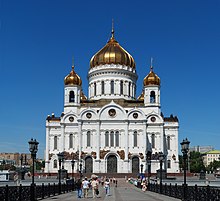Cathedral of Christ the Saviour
The Cathedral of Christ the Savior (Russian: Храм Христа́ Спаси́теля, tr. Khram Khristá Spasítelya, IPA: [xram xrʲɪˈsta spɐˈsʲitʲɪlʲə]), is a Russian Orthodox cathedral located in Moscow on Sparrow Hill, on the banks of the Moskva River, it is known for having been demolished in the 1930s for the construction of the Palace of the Soviets, which was never made.[4]
| Cathedral of Christ the Saviour | |
|---|---|
Храм Христа Спасителя Khram Khrista Spasitelya | |
 The new Cathedral of Christ the Saviour as viewed from the bridge over the Moscow River | |
| 55°44′40″N 37°36′20″E / 55.74444°N 37.60556°E | |
| Location | Moscow, Russia |
| Denomination | Russian Orthodox Church |
| Website | www |
| History | |
| Consecrated | 19 August 2000 |
| Architecture | |
| Style | Russian Revival |
| Specifications | |
| Capacity | 10,000 people[1] |
| Length | 79 m (length-width)[1] |
| Height | 103.4 m (top cross)[2] 91.5 (top dome)[2] 69.5 (dome ceiling)[2] |
| Nave height | 37 m (interior)[1] |
| Other dimensions | 194,900 m3 [2] |
| Floor area | 3,980 m2[3] |
| Dome diameter (outer) | 29.8 m[2] |
History
changeThe Original Cathedral had been built by order of Tsar Alexander I of Russia, in honor of Christ the Savior, stating on December 25, 1812: "To express our gratitude to Divine Providence for saving Russia from the Ruin that overshadowed it" (due to the Napoleonic Wars), the design of the cathedral was in charge of the architect Aleksandr Lavrentyevich Vitberg in 1817, who designed it with a Neoclassical design in the style of Masonic Symbolism, after the succession of Alexander I by his brother, Nicholas I, he would not like the architecture of the previous design and would hire his trusted architect Konstantin Thon.
The new architect would be based on the design of Neo-Byzantinism, and would be based on Hagia Sophia (Previously the Basilica of Saint Sophia until the Fall of Constantinople), in Istanbul and in 1832 the Russian Architectural Renaissance would be approved, in the place a old Convent and Church and the first stone would be laid until 1839, the interior would be painted by the best Russian painters of the time and the scaffolding would not be removed until 1860, and the dome would be placed using the Electroplating technique,[5] and in 1882 Tchaikovsky would premiere the 1812 Overture, even though the cathedral was half finished, it would finally be consecrated on May 26, 1883, one day after the coronation of Alexander III, its interior had paintings of Russian saints and the Napoleonic withdrawal from Moscow.[6]
After the Russian Revolution, the place was closed due to religious persecution in Russia. After the death of Lenin and succession by Stalin, he saw the Churches in Moscow as an unnecessary space and would decide to demolish them. In the place of the Cathedral, the Construction of a Palace for the Supreme Soviet of the USSR, and in 1930 this idea would start, this work would be in charge of Mikhail Kalinin and before demolishing the cathedral, around 25 tons of gold would be removed, Stalin saw the cathedral as an unnecessary luxury for the Soviet state and the demolition would begin on July 23, 1931 to try to erase Russia's imperial past, which this cathedral represented.[7]
After the demolition the land would be flattened and a ditch would be made, and in 1938 the foundations of the new palace would be laid but the construction would stop due to the flooding of the river and the German invasion of the USSR, the material for the palace would be destined for the war,[2] the project would try to resume construction but finally it would be canceled in 1957 and the Moskva Pool would be built in the place, the largest heated pool in the world, after the Fall of the USSR, many people asked for the reconstruction of the cathedral which would begin in 1995 to be finally consecrated in 2000, would be reconstructed in detail based on photos and the original plan of the Konstantin Thon cathedral.
The punk rock group Pussy Riot organized a Guerrilla rig in front of this cathedral due to the support of the Orthodox Church to Vladimir Putin, three of the members were arrested.[8][9]
References
change- ↑ 1.0 1.1 1.2 "Храм Христа Спасителя". Archived from the original on 2020-07-27. Retrieved 2022-04-09.
- ↑ 2.0 2.1 2.2 2.3 2.4 2.5 "Основные размеры Храма Христа Спасителя".
- ↑ Sidorov, Dmitri (2000). "National Monumentalization and the Politics of Scale: The Resurrections of the Cathedral of Christ the Savior in Moscow". Annals of the Association of American Geographers. 90 (3): 548–572. doi:10.1111/0004-5608.00208. JSTOR 1515528. S2CID 144856387.
- ↑ "ХРАМ ХРИСТА СПАСИТЕЛЯ". www.xxc.ru. Archived from the original on 2 December 2010. Retrieved 5 January 2018.
- ↑ The history of galvanoplating in Russia Archived 5 March 2012 at the Wayback Machine (in Russian)
- ↑ Ратьковский И.С., Ходяков М.В. (1999). История Советской России, Изд-во "Лань", pp. 137-149.
- ↑ Eastern Europe, Russia and Central Asia. Taylor & Francis. 2002. p. 46. ISBN 1857431375.
- ↑ Rumens, Carol (20 August 2012). "Pussy Riot's Punk Prayer is pure protest poetry". TheGuardian.com. Guardian News & Media. Retrieved 8 April 2022.
- ↑ Pussy Riot gig at Christ the Saviour Cathedral (original video). 2 July 2012. Archived from the original on 24 August 2012. Retrieved 8 April 2022.
Other websites
change- Travel2moscow.com – Official Moscow Guide
- Official website, with full details of the construction and reconstruction history.
- Cathedral of Christ the Saviour in Moscow by Evgenia Kirichenko
- Cathedral of Christ the Saviour in Moscow: A Russian Allegory
- Churches Around the World Archive Archived 2008-12-04 at the Wayback Machine
- 360° Virtual Tour of the Cathedral of Christ the Saviour
